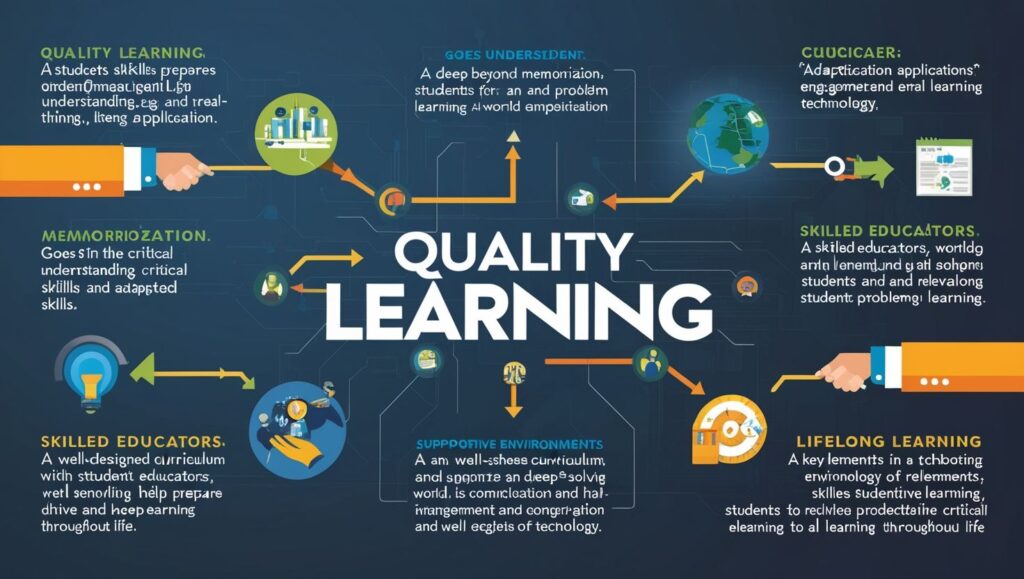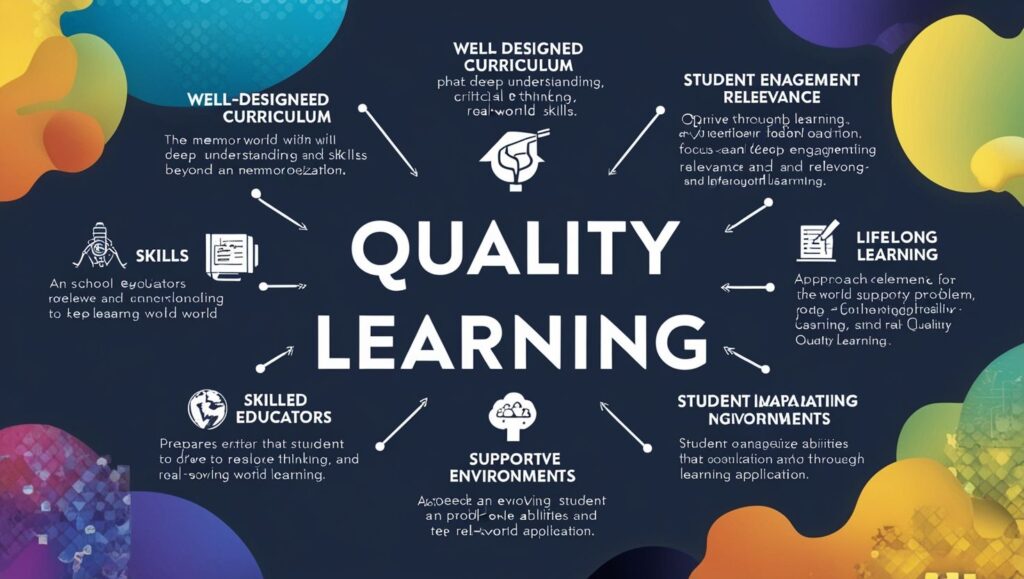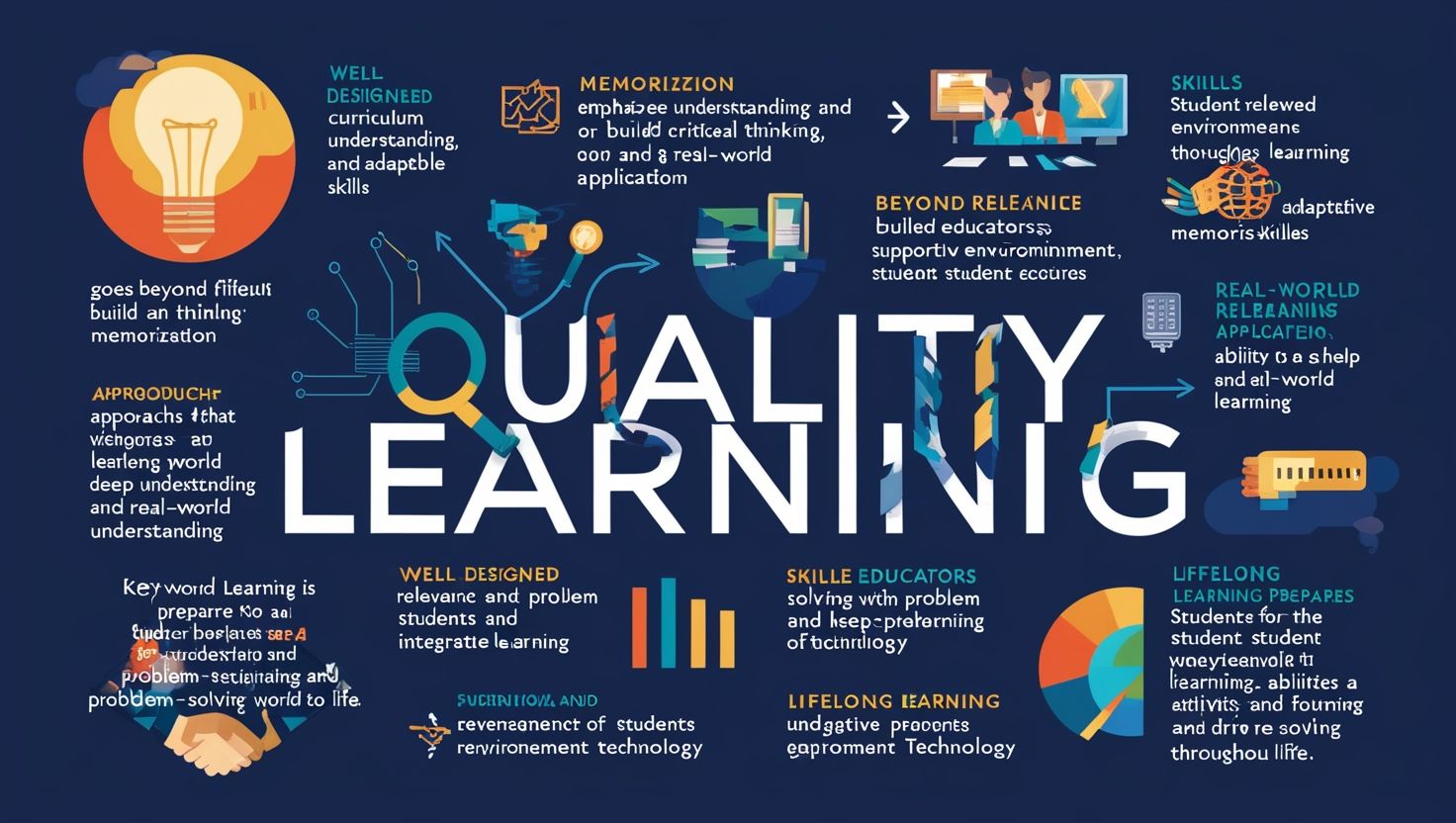Introduction
Quality Learning is an educational approach focused on fostering depth of understanding, critical thinking, and adaptability among learners. Unlike traditional methods that often prioritize rote memorization, quality learning emphasizes comprehension, skill-building, and the ability to apply knowledge in real-world situations. In today’s fast-paced world, where knowledge and technology rapidly evolve, quality learning prepares students for lifelong learning and adaptability. This article delves into the core aspects of quality learning, examining its defining characteristics, influential factors, pedagogical strategies, and the role of educators and institutions in promoting high standards of education.
Characteristics of QL
Quality learning encompasses a variety of characteristics that distinguish it from conventional methods:
- Critical Thinking and Problem Solving: It encourages students to analyze, evaluate, and create solutions to real-world challenges. This approach fosters independence and nurtures intellectual curiosity.
- Comprehensive Understanding and Depth: Unlike surface-level memorization, quality learning prioritizes deep comprehension of subjects, enabling students to understand foundational principles and connect concepts across disciplines.
- Engagement and Relevance: itrelates content to students’ lives, making education relevant and meaningful. This relevance boosts student engagement and motivation, creating an environment that is both stimulating and nurturing.
- Adaptability and Lifelong Learning: With the rapidly changing landscape of knowledge, adaptability is crucial. Quality learning equips students with tools for continuous learning, encouraging them to adapt and thrive in diverse contexts.
- Focus on Skills over Content: While content remains essential, quality learning emphasizes skills like communication, collaboration, and creativity. Such skills are valuable across various disciplines and professions.
Factors Influencing QL
Several factors shape the quality of learning experiences:
- Curriculum Design and Content: A curriculum that is well-rounded, comprehensive, and contextually relevant is vital for quality learning. The curriculum should emphasize understanding, critical thinking, and real-world application rather than rote memorization.
- Instructional Methods: Teaching methods influence the quality of learning. Interactive and student-centered teaching methods, such as project-based learning and inquiry-based approaches, help cultivate a deeper understanding of the material.
- Teacher Competency and Dedication: Teachers play a pivotal role in fostering quality learning. Competent and dedicated teachers who are well-versed in subject matter and pedagogical techniques can inspire students and effectively facilitate learning.
- Educational Environment: A safe, supportive, and inclusive learning environment enhances the learning experience. This environment should encourage open discussion, exploration, and experimentation without fear of failure.
- Parental and Community Involvement: Involving parents and communities in the educational process can reinforce learning and help students feel more connected to their studies. It also fosters a collaborative learning environment that extends beyond the classroom.
- Technological Integration: Technology can greatly enhance the quality of learning by providing diverse resources, fostering interactive learning, and enabling customized educational experiences.

Strategies for Promoting QL
Implementing it requires an intentional, multi-faceted approach:
- Differentiated Instruction: Students have unique needs and learning styles. Differentiated instruction tailors teaching strategies and content to suit individual student profiles, enabling each learner to grasp concepts at their pace.
- Inquiry-Based Learning: This approach encourages students to ask questions, investigate topics of interest, and actively engage with content. By promoting inquiry, teachers can inspire students to become active participants in their learning journey.
- Formative Assessment and Feedback: Regular assessments that emphasize feedback over grades allow students to identify areas for improvement. Constructive feedback can guide students’ efforts, helping them to focus on critical areas and develop their skills.
- Collaborative Learning: Group work and collaborative projects enable students to learn from one another, fostering interpersonal skills and exposing them to diverse perspectives.
- Encouraging Reflective Thinking: Reflective thinking helps students assess their progress, understand their strengths and weaknesses, and make informed adjustments to their learning strategies. Reflection can be cultivated through journaling, peer reviews, or self-assessment exercises.
- Use of Real-World Applications: Integrating real-world examples and case studies into lessons provides context and makes learning more applicable. This approach bridges the gap between theoretical knowledge and practical experience, fostering a deeper understanding of subjects.
Role of Teachers and Educational Institutions
Educators and institutions play a significant role in establishing a quality learning framework. Teachers act as facilitators, guiding students through the learning process while fostering independence and critical thinking. Instructors are responsible for creating a supportive classroom atmosphere, setting clear learning objectives, and providing personalized attention to address individual student needs.
Educational institutions, on the other hand, are tasked with creating the infrastructure and support systems necessary for quality learning. This includes providing adequate resources, promoting a culture of learning, and ensuring that faculty members are well-trained in advanced pedagogical practices. Institutions also play a role in creating policies that uphold high standards of learning while adapting to contemporary educational demands.
Challenges in Implementing of this approach
Despite the evident benefits, implementing quality learning is not without its challenges:
- Resource Constraints: Schools with limited financial and material resources may struggle to provide the tools needed for interactive and quality education, including technology, books, and laboratory equipment.
- Teacher Training and Development: Not all teachers have access to ongoing professional development. Without continuous training, educators may lack the necessary skills to implement quality learning strategies effectively.
- Standardized Testing Pressures: Many educational systems prioritize standardized testing, which can hinder quality learning by focusing on memorization rather than understanding and skill-building.
- Classroom Size and Diversity: Large classrooms with diverse student backgrounds and abilities make it difficult for teachers to provide personalized attention. This can create a barrier to achieving the high standards of quality learning.
- Resistance to Change: Shifting from traditional methods to quality learning practices often faces resistance from educators, parents, and policymakers who are accustomed to conventional approaches.

Global Trends in QL
Around the world, educational reforms have been increasingly focused on fostering it. Countries such as Finland and Singapore, known for their high-performing education systems, prioritize quality over quantity in their curricula. Their emphasis on student-centered teaching, teacher development, and skill-building serves as a model for effective educational strategies.
Incorporating technology in education is another global trend that supports quality learning. Digital tools and online platforms offer a wealth of resources, enabling personalized learning and enhancing student engagement. With the shift toward digital learning, schools and institutions are better able to address individual learning needs, thereby promoting quality in education.
Conclusion
Quality learning is fundamental to preparing students for a world that demands adaptability, critical thinking, and practical skills. By focusing on comprehensive understanding, relevant skills, and fostering a lifelong love for learning, educators and institutions can contribute to the holistic development of learners. Although challenges exist in implementing quality learning, with adequate resources, dedicated educators, and supportive institutions, it is possible to overcome these hurdles. Embracing quality learning not only benefits individual students but also contributes to building knowledgeable, adaptable, and responsible citizens capable of making meaningful contributions to society.
References
- Anderson, L. W., & Krathwohl, D. R. (2001). A Taxonomy for Learning, Teaching, and Assessing: A Revision of Bloom’s Taxonomy of Educational Objectives. New York: Longman.
- Hattie, J. (2009). Visible Learning: A Synthesis of Over 800 Meta-Analyses Relating to Achievement. Routledge.
- Darling-Hammond, L., & Bransford, J. (2005). Preparing Teachers for a Changing World: What Teachers Should Learn and Be Able to Do. Jossey-Bass.
- OECD (2018). The Future of Education and Skills: Education 2030. Retrieved from OECD.org
- Slavin, R. E. (2014). Educational Psychology: Theory and Practice. Pearson Education.
- Schunk, D. H. (2012). Learning Theories: An Educational Perspective. Pearson Education.

6 thoughts on “Quality Learning”
Comments are closed.